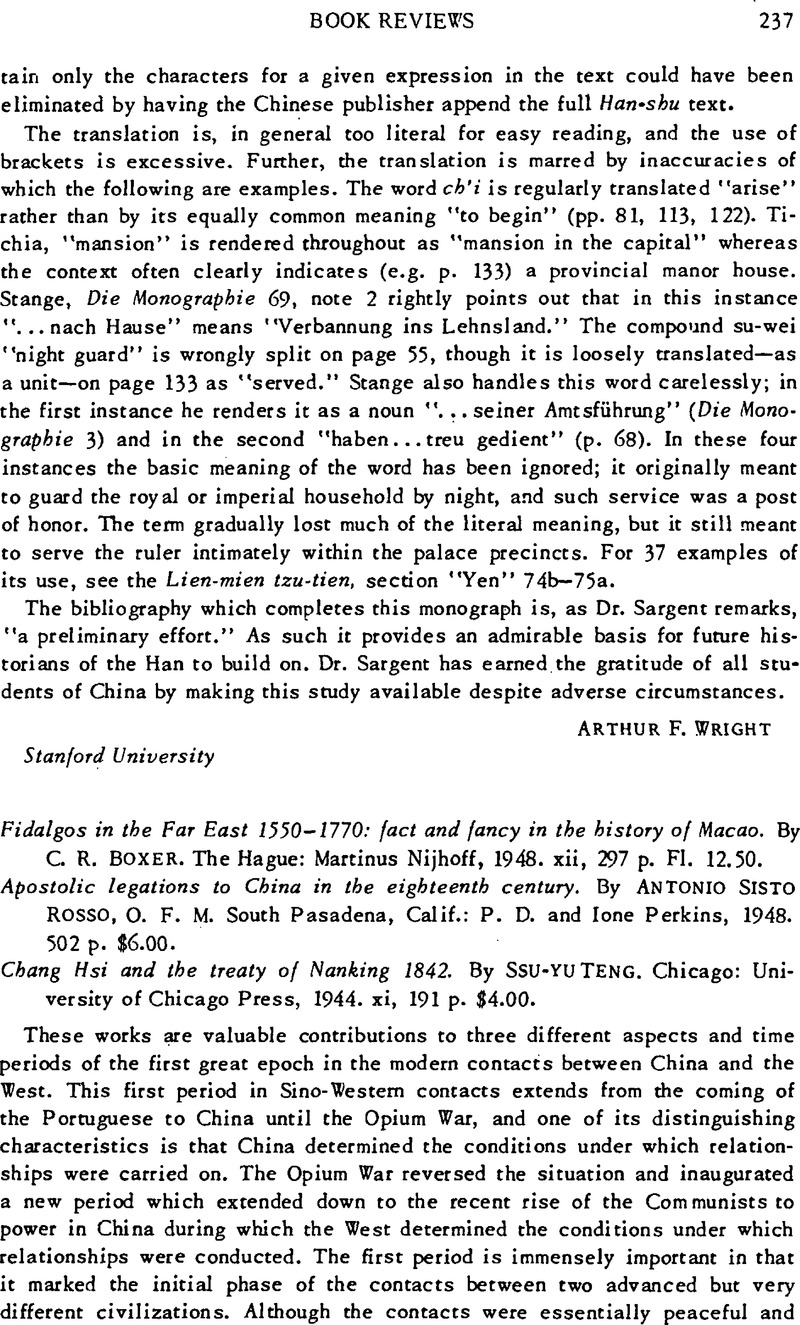No CrossRef data available.
Published online by Cambridge University Press: 23 March 2011

1 SirSansom, George in part 1 of his The Western World and Japan (New York: Knopf, 1930)Google Scholar makes numerous interesting and stimulating generalizations and suggestions about the contacts between Europe amd Southern and Eastern Asia, but it is in no way a substitute for the type of study suggested.
2 Within the last twenty years a number of studies dealing with early Portuguese contacts with China have been published, but the later history of Macao, its trade and relations with China, remain but imperfectly covered in Montalto de Jesus' Historic Macao (Hongkong, 1902: Macao, 1926). Among the more important of these recent works are: Chang T'ien-tse, Sino-Portuguese Trade from 1514 to 1644 (Leyden: E. J. Brill, 1934), which should be used in connection with Pelliot's review in T'oung pao, 31 (1934), 58–94 and Pelliot's “Le Hōja et le Sayyid Husain de l'histoire des Ming,” TP, 38 (1948), 81–292, which clarifies many points about the embassy of Tome Pires and other things; see also Armando Cortesão's introduction to the Suma Oriental of Tomé Pires (2 vols. London: Hakluyt Society, 1944); Bernard, Henri, Aux portes de la Chine: les missionnaires du seizieme siècle 1514–1588 (Tientsin: Sienshien, 1933)Google Scholar; Wei-hua, Chang, “The first embassy of Portugal to China” (in Chinese), Shih-hsüeh nien pao (Yenching annual of historical, studies), 1 (Oct. 1933), 103‐12Google Scholar and his Ming shib Fo-lang-chi, Lü-sung, Ho-lan, l-ta-li-ya ssu ch'uan cbu-shib (a commentary of the four chapters on Portugal, Spain, Hollanid and Italy in the history of the Ming dynasty) (Peiping: Harvard-Yenching Institute, 1934); Kammerer, Albert, La decouverte de la Chine par les Portugais au XVleme siècle et la cartographie des Portulans (Leyden: E. J. Brill, 1944)Google Scholar is especially valuable,, while Boxer has edited an extremely important historical source relating to Macao written in 1744–56, Azia Sinica e Japonica. Obra postuma e inédita do frade Arrabido José de Jesus Maria (2 vols. Macao, 1941 and 1950); Braga, J. M., “The Western pioneers and their discovery of Macao,” Boletim do Instituto Português de Hongkong, 2 (Macao, 1949), 7–214Google Scholar, Brazão, Eduardo, Apontamentos para a historia das relacões diplomaticas de Portugal com a China, 1516–1753 (Lisbon: Agência Geral das Colónias, 1949)Google Scholar, and Teixeira, Padre Manuel, Macau e a sua diocese (2 vols. Macao, 1940)Google Scholar, promise to be of great value, although the reviewer has not yet seen them.
3 Latourette's, K. S. invaluable History of Christian Missions in China (New York: Macmillan, 1929)Google Scholar devotes only a fraction (120 p.) of its total space to the missions of the sixteenth to eighteenth centuries. Perhaps the most comprehensive and satisfactory published study in English is Rowbotham's, Arnold H.Missionary and mandarin (Berkeley: University of California Press, 1942)Google Scholar, but it concentrates on the Jesuits, has by no means exhausted the relevant source materials, and has not developed certain aspects of the subject as much as might be desirable.
4 Two other recent works relating to the latter part of this first period of Sino-Western relations should be noted: Cammann, Schuyler, Trade through the Himalayas: the early British attempts to open Tibet (Princeton University Press, 1951)Google Scholar, and Michael Greenberg, British trade and the opening of China, 1800–1842 (Cambridge University Press, 1951), which continues chronologically the reviewer's two books on Sino-British trade and relations. It is based to a considerable extent upon the Jardine Matheson & Co. papers in the Cambridge University Library, England.
5 Attention should be called to three other recent books relating to this first period of Sino-Western contacts: Pavlovsky's, Michel N.Chinese-Russian relations (New York: Philosophical Library, 1949)Google Scholar makes useful contributions to the history of Sino-Mongol-Russian relations and to other Russian contacts with China in the seventh century; Appleton's, William W.A Cycle of Cathay (New York: Columbia University Press, 1951)Google Scholar is an extremely valuable study of the Chinese vogue in England during the seventeenth and eighteenth centuries, and Gallagher's, L. J. S. J. The China that was (Milwaukee: Bruce Publishing Co., 1942)Google Scholar is a useful translation of the first book of Nicholas Trigault's, S. J.De Christiano expeditione apud sinas… (Amsterdam, 1615)Google Scholar, which gives a valuable picture of China and its institutions as seen by the missionaries during the last days of the Ming dynasty.